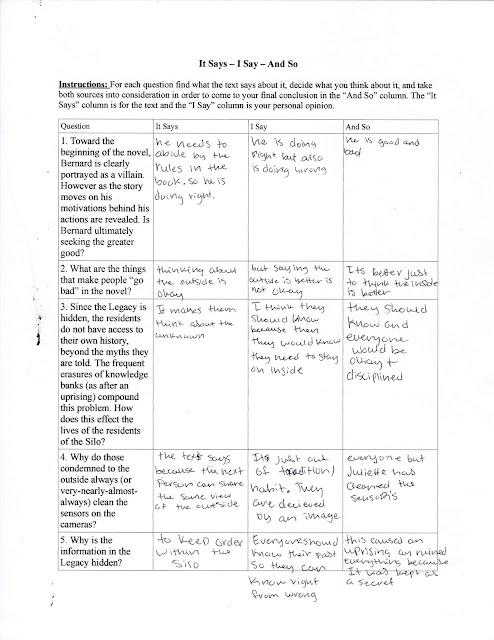Gallagher, K. (2009). Readicide, Finding the sweet spot (pp.90-109). Portland, ME: Stenhouse.
What Matters: Meeting Content Goals through Teaching Cognitive Reading Strategies with Canonical Texts by: Styslinger, Ware, Bell and Barrett
Say:
What Matters: Meeting Content Goals through Teaching Cognitive Reading Strategies with Canonical Texts by: Styslinger, Ware, Bell and Barrett
Say:
This week's reading, specifically in Readicide, created some strong opinions in myself. For one, she only confronted the issue of readicide that happens to classic titles. To be honest, I'm not a huge proponent for the canon. I think the canon serves it's purpose for certain environments and classrooms, however most students don't need to be exposed to more than a few canonical texts in their entire lifetime. This is especially true if they are not planning on pursuing English and Literature in their post-secondary careers. It's even more true if they don't plan on pursuing a post-secondary degree at all.
Gallagher claims that most school districts don't allot enough time to include other texts besides canonical texts, but I think that she is stretching it a bit. I'm sure she could find the time if she skipped over the boring author's biography that no student ever remembers. She could definitely find the time if she didn't talk about the historical context if it really isn't needed for comprehension of the text. And she could always pair the canonical text with a multi-cultural or YA lit novel.
Gallagher also suggests that having students read the same title is beneficial. However, a flaw I found in her theory is that she only applies this theory to classical literature. What about literature that is way more relevant to our students, like YA? I think that doing book clubs or assigning supporting texts to all students would be more beneficial to my students. This is primarily because if all of the students are struggling with a canonical text, then they can refer to the supporting texts to extrapolate comprehension, analysis and meaning.
I don't agree that classical literature can illuminate modern cultural literacy. Culture is changing. Classical texts can be used as a means to peer into the culture of the time in which it was written. This comment precedes her opinion that canonical texts can also expose students to a certain kind of rigor. I think this is true, but can't any other text that uses advanced vocabulary and deeper meanings?
The biggest issue I have with Gallagher is that she tends to support canonical texts so much that she almost pushes out other kinds of literature. At this point in my life, I don't agree with her thoughts because I currently have a multi-cultural pedagogy and believe that YA literature can bring about relevant meaning to my students better than any canonical text.
I do agree that the problem lies with how a piece of literature, especially a classic, is taught.
But then Gallagher lets me down again! She states that she teaches classics in her classroom so that students can extrapolate a universal meaning out of it. Can't you do that with any of kind of text? Yes. Or let's take her comment about how likable at text is. Gallagher isn't worried about whether her students like the text, but whether or not they get something from it. I just don't think students will get anything from a book if they don't have even an inkling of interest in it.
In the text that Styslinger took a part in, cognitive reading strategies were discussed. They talked about it in the context of studying classical literature, but I think it can be effective for any kind of text. This is especially true if you have CP students. In that article many teachers focused on one strategy for a text and others chose to use multiple to aid in the comprehension of a text. I think that it depends on the text and the students. A teacher must know their students and know the text.
Cognitive reading strategies are a great way to decompose a canonical text, it can also be used for YA literature and multi-cultural texts. One of the cognitive reading strategies that I was able to use during EDRD 600 was "It Says-I Say-And So". My student and I were reading Wool and I was able to use it in order to break down important parts of the text. The artifact is there below.
"I am a teacher, not an assigner"
Do:

I think that your reaction to Gallagher is interesting. I like that you take a view point against the article. I personally am a fan of the canon for some of the reasons that Gallagher gives, but I also think that it will be hard to get students to find an interest in Great Expectations, or Aristotle's Poetics. The best way seems to be what we've been doing in class with Brave New World where we have the canon as a jumping off point for other texts that might be more interesting to fourteen year olds.
ReplyDeleteI appreciate your Do--especially as it brings a reading strategy to life--and I do appreciate your strong opinions about the canon--but I am questioning why everything has to be an extreme in education? Can't we find a way to teach the canon AND YA? Does everything have to be one extreme or the other? How can we find the balance? The reading is also about balancing underteaching with overteaching--you don't respond to a lot of the reading assigned for this week--you missed a chunk of it----what about your review of Beers or the Appleman or the Milner or the new reading about vocabulary? When you consider all of the reading it becomes more than just a canonical argument--it's about finding the balance between strategies, analysis, and still finding that aesthetic experience with text--
ReplyDelete